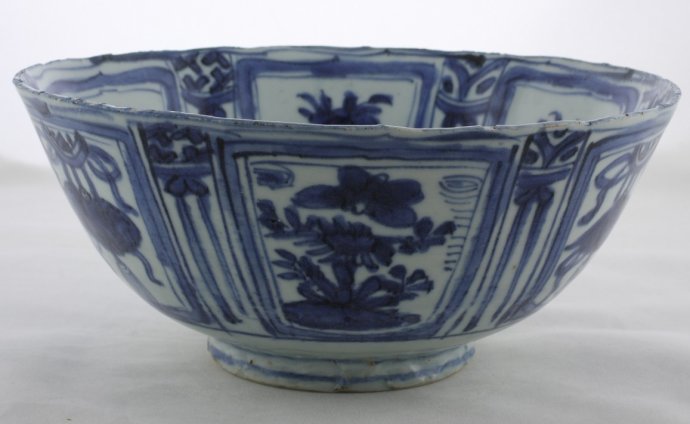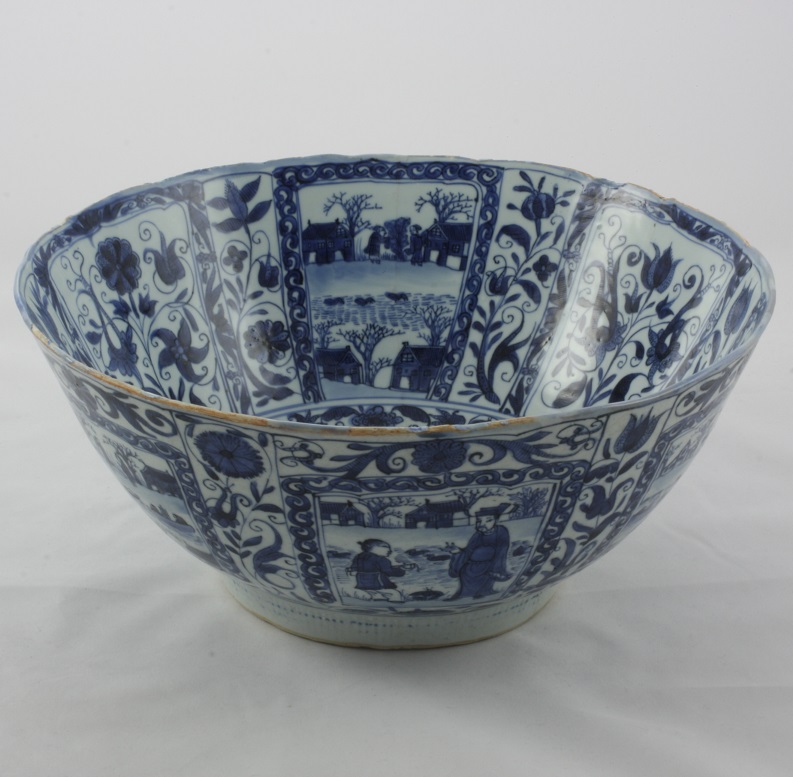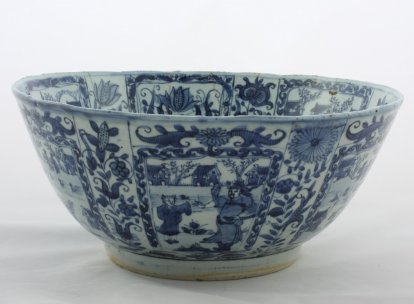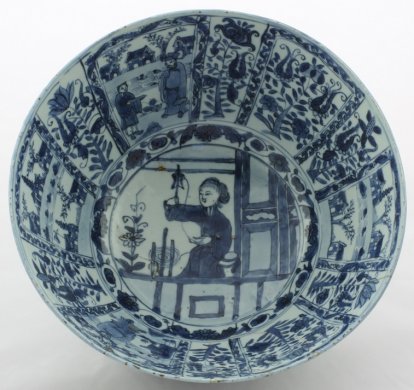Sold Ceramcis
Sold Kraak Porcelain wares 1570-1645
Bowls
Page 1
Dutch merchants arrived in Asia towards the end of the 16th century. The The Dutch East India Company, (Vereenigde Oost-Indische Compagnie, VOC), was founded in 1602, competed fiercely with the Portuguese as traders. Porcelain from captured Portuguese vessels (caraccas) was called kraak porcelain, a Dutch corruption of the Portuguese word. It was made especially for export in Jingdezhen, the porcelain centre in Jiangxi Province. The VOC shipped it in huge quantities and soon it was a commonplace item in Dutch interiors.
Kraak porcelain was primarily bought for practical use but pieces also had decorative functions. The paintings, done in underglaze blue only, show landscapes and animals, rarely human figures, making this porcelain suitable for Islamic markets, too. Buddhist and Daoist good luck symbols make up the panelled border decorations. Plates and dishes were moulded. They are thin, usually rather quickly finished and often have kiln grit adhering to the underside. The glaze on the edge is often retracted. Apart from large dishes, the bases of other objects are glazed, and the V-shaped footring is slightly undercut. Initially, the panels on kraak porcelain were raised, but this feature disappeared at the end of this period.
There are certain general characteristics which can help in the recognition of Kraak Bowls.
The rim is always foliated with the exception of one type (Shape II), all Kraak bowls have an everted rim which may at times also be upturned. (Shape IV). Footrings are thin, usually straight and high. Bases, with very few exceptions, are always glazed, often convex and with chatter marks. Unlike dishes and klapmutsen, Kraak bowls do not have the common denominator of border styles. Bowls have been categorized according to their often very distinctive shapes. There are six such shapes, each bearing one or more typical decorative motifs, which determine a subdivision.
Shape I (c.1570-1610) with everted rim
- Shape I.1 with deer motif (c.1575-1610)
- Shape I.2 with flying horse motif (c.1585-1610)
- Shape I.3 with crowcup features (c.1590-1610)
- Shape I.4 with flower sprays (c.1585-1600)
Shape II (c.1580-1645) with straight rim
- Shape II.1 with cakra motifs (c.1580-1645)
- Shape II.2 with flying horse motifs (c.1575-1600)
Shape III (c.1575-1605) with lobed sides
Shape IV (c.1595-1645) crowcups
- Shape IV.1 typical crowcups (c.1585-1645)
- Shape IV.2 crowcups without panels (c.1595-1620)
Shape V (c.1620-1635) bell cups
Shape VI (c.1590-1650) large size bowls
- Shape VI.1 early large bowls (c.1590-1630)
- Shape VI.2 Hatcher cargo bowls (c.1635-1645)
- Shape VI.3 bowls with Transitional features (c.1635-1650)
(source: Rinaldi 1989, pp.138-165)

Sold Ceramics - Sold Kraak Porcelain wares 1570-1645 - Bowls - Page 1
Object 2010723
Bowl
China
1620-1640
Height 95 mm (3.74 inch), diameter of rim 215 mm (8.47 inch), diameter of footring 85 mm (3.35 inch)
Bowl on footring, straight rim with foliated edge. Decorated in underglaze blue with on the outside large panels filled with flowering plants and a butterfly in flight alternating with narrow panels with hanging ribbons. On the inside in the centre hanging tassels and ribbons and on the sides large panels filled with flowering branches alternating with narrow panels with hanging ribbons.
According to Rinaldi this bowl can be classified as a small Shape VI.2 bowl. These bowls, the largest in kraak wares are about 350 mm (13.78 inch) to 360 mm (14.17 inch) in diameter at the mouthrim. They have rounded walls ending in a straight rim. Walls do not have a moulded deign any more, but the decoration is organized in the typical kraak manner: large and narrow panels on the walls and around a centre medallion.
This bowl is a small and rare version of a Shape VI.2 bowl.
For a similarly shaped, sized and decorated bowl, please see:
Condition: A hairline and some tiny frits to the rim.
References:
Volker 1954, reprint 1971, Pl. XXVI, cat. 45a & 45b
Price: Sold.
Sold Ceramics - Sold Kraak Porcelain wares 1570-1645 - Bowls - Page 1
Object 2012027
Bowl
China
1630-1645
Height 151 mm (5.95 inch), diameter of rim 337 mm (13.27 inch), diameter of footring 144 mm (5.67 inch), weight 2,657 grams (93.72 ounce (oz.))
Bowl on footring, straight rim with foliated edge. Kiln sand adhering to the inner footring. Decorated in underglaze blue with a riverscape with houses, trees and figures in a central medallion surrounded by a broad floral scroll border. Both in- and outside walls are divided in six large and six narrow panels. The large panels have a floral scroll border, three are filled with Chinese figures and river scenes with houses and trees, the other three are filled with Iznik-like flowers, the narrow panels are filled with tulips and flowers. Above the footring a broad floral scroll border.
According to Rinaldi this bowl can be classified as a Shape VI.3 bowl with Transitional features (c.1635-1650). The shape and body of these bowls comply with kraak characteristics, yet their decoration has adopted features typical of the Transitional style: it is much more elaborate and stylized and includes narrative scenes with figures as well as Dutch flowers, tulips and Iznik style flowers. The centre medallions offer a very wide selection of motifs, either typically Chinese or with European influence. The broad border around the centre medallion is decorated with a variety of motifs, like simple or floral scrolls, palmettes and semicircles. Both inside and outside walls are divided in large and narrow panels from three to six each. The large panels have a border with scrolls or vegetal motifs and are usually filled with extremely stylized and thinly-drawn flowers with Iznik influence or with European houses with Chinese figures. The narrow panels are filled with tulips and thinly-drawn flowers with Iznik influence. These bowls are an exact parallel with Border IX dishes and should be dated accordingly: 1635-1650. Curiously, while there are several Border IX dishes in the Topkapi Saray, there are no bowls with Transitional features. This would indicate that the production was mainly intended for the Dutch home market where most of these bowls are still to be found today. (Rinaldi 1989, pp.163-164)
Although the manufacture and the division into panels are still in kraak style, the decoration is Transitional, in particular the use of the 'tulip' motif. It has been suggested that the spinner and the houses were derived from European prints and drawings, but there is no evidence for this as yet. (Jörg 1984, pp.54-55, cat. 11 & Jörg 2011/1, pp.144-145, cat. 40)
For identically shaped, sized and decorated with the riverscape motif bowls, please see:
- Het Chinese porselein in de collectie Frits Lugt / The Frits Lugt collection of Chinese porcelains, (D.F. Lunsingh Scheurleer in Mededelingenblad Nederlandse Vereniging van Vrienden van de Ceramiek, vols. 103/104, Lochem 1981), pp.65-66, cat. 70.
- Kraak porcelain. A moment in the history of trade, (M. Rinaldi, Bamboo Publishing Ltd, London 1989), p.164, Pl.203.
- Austrumu porcellans un Niderlande. Austrumu un Rietumu mijiedarbiba 17. gadsimta / Oriental Porcelain and the Netherlands. Interaction between East and West in the 17th century, (C.J.A. Jörg, Art Museum Riga Bourse, Riga, 2011), pp.144-145, cat. 40.
- Four Centuries of Blue & White. The Frelinghuysen Collection of Chinese And Japanese Export Porcelain, (B. MacGuire, Ad Ilissum / Paul Holberton Publishing, Chicago, 2023), p.240, cat. 193.
For another identically shaped and sized bowl, decorated with 'the Spinner'' motif, please see:
For another identically shaped and sized bowl that on the outer wall is decorated with a continuous landscape scene with various figures in a typical Chinese style but on the inside is decorated with the same large and narrow panels filled with European houses with Chinese figures and tulips and thinly-drawn flowers with Iznik influence, please see:
Another extremely rare, unusually large Dutch (Delft) faience bowl closely follows a Chinese model in shape and size, but the panels are decorated with Chinoiseries composed of exotic Chinese decorative elements rendered in a personal, Western way by the painter in Delft, please see:
Condition: Some glaze rough spots to the rim, two hairlines and two re-stuck pieces to the wall.
References:
Lunsingh Scheurleer 1981, cat. 73
Rinaldi 1989, pp.163-164, Pl.203
Price: Sold.
Sold Ceramics - Sold Kraak Porcelain wares 1570-1645 - Bowls - Page 1
Object 2011834
Bowl
China
1630-1645
Height 152 mm (5.98 inch), diameter of rim 340 mm (13.39 inch), diameter of footring 152 mm (5.98 inch), weight 2,198 grams (77.53 ounce (oz.))
Bowl on footring, straight rim with foliated edge. Kiln sand adhering to the base. Decorated in underglaze blue with 'the Spinner' motif in a central medallion surrounded by a broad floral scroll border. Both in- and outside walls are divided in six large and six narrow panels. The large panels have a floral scroll border and are filled with Chinese figures and river scenes with houses, the narrow panels are filled with tulips and flowers. Above the footring a broad floral scroll border.
According to Rinaldi this bowl can be classified as a Shape VI.3 bowl with Transitional features (c.1635-1650). The shape and body of these bowls comply with kraak characteristics, yet their decoration has adopted features typical of the Transitional style: it is much more elaborate and stylized and includes narrative scenes with figures as well as Dutch flowers, tulips and Iznik style flowers. The centre medallions offer a very wide selection of motifs, either typically Chinese or with European influence. The broad border around the centre medallion is decorated with a variety of motifs, like simple or floral scrolls, palmettes and semicircles. Both inside and outside walls are divided in large and narrow panels from three to six each. The large panels have a border with scrolls or vegetal motifs and are usually filled with extremely stylized and thinly-drawn flowers with Iznik influence or with European houses with Chinese figures. The narrow panels are filled with tulips and thinly-drawn flowers with Iznik influence. These bowls are an exact parallel with Border IX dishes and should be dated accordingly: 1635-1650. Curiously, while there are several Border IX dishes in the Topkapi Saray, there are no bowls with Transitional features. This would indicate that the production was mainly intended for the Dutch home market where most of these bowls are still to be found today. (Rinaldi 1989, pp.163-164)
Although the manufacture and the division into panels are still in kraak style, the decoration is Transitional, in particular the use of the 'tulip' motif. It has been suggested that the spinner and the houses were derived from European prints and drawings, but there is no evidence for this as yet. (Jörg 1984, pp.54-55, cat. 11 & Jörg 2011/1, pp.144-145, cat. 40)
The lady reeling, on the inside in the centre, may be Huang Tao P'o. She lived in the 14th century and is said to have invented the flocking-bow and loom and to have taught people the art of spinning and weaving. (Hartog 1990, p.48, cat. 21)
For identically shaped, sized and decorated with 'the Spinner' motif bowls, please see:
- Oosters porselein. Delfts aardewerk. Wisselwerkingen, (C.J.A. Jörg, Groningen, 1983), p.67, cat 11.
- Interaction in Ceramics. Oriental porcelain and Delftware. (C.J.A. Jörg, Hong Kong, 1984), pp.54-55, cat. 11.
- Kraak porcelain. A moment in the history of trade, (M. Rinaldi, Bamboo Publishing Ltd, London 1989), p.163, Pl.202.
- Pronken met Oosters porselein, exhibition catalogue Gemeente Museum Arnhem, (S. Hartog, Waanders, Zwolle 1990), p.48, cat. 21.
Other identically with 'the Spinner' motif decorated bowls are in the collections of the Arnhem Gemeentemuseum (inv. no. V1-T) and the Groninger Museum (inv. nr. 1978-138), The Netherlands and in the Troesch Collection, Switzerland. (Rinaldi 1989, p.163, Pl.202)
For another identically shaped and sized bowl that on the outer wall is decorated with a continuous landscape scene with various figures in a typical Chinese style but on the inside is decorated with the same large and narrow panels filled with European houses with Chinese figures and tulips and thinly-drawn flowers with Iznik influence, please see:
Another extremely rare, unusually large Dutch (Delft) faience bowl closely follows a Chinese model in shape and size, but the panels are decorated with Chinoiseries composed of exotic Chinese decorative elements rendered in a personal, Western way by the painter in Delft, please see:
Condition: Some minor frits to the rim and a large hairline running from the rim to deep inside the base. A second shorter hairline with two old, silver wire, restorations. Two re-stuck pieces to the wall.
References:
Rinaldi 1989, pp.163-164, Pl.202
Price: Sold.






 create websites
create websites